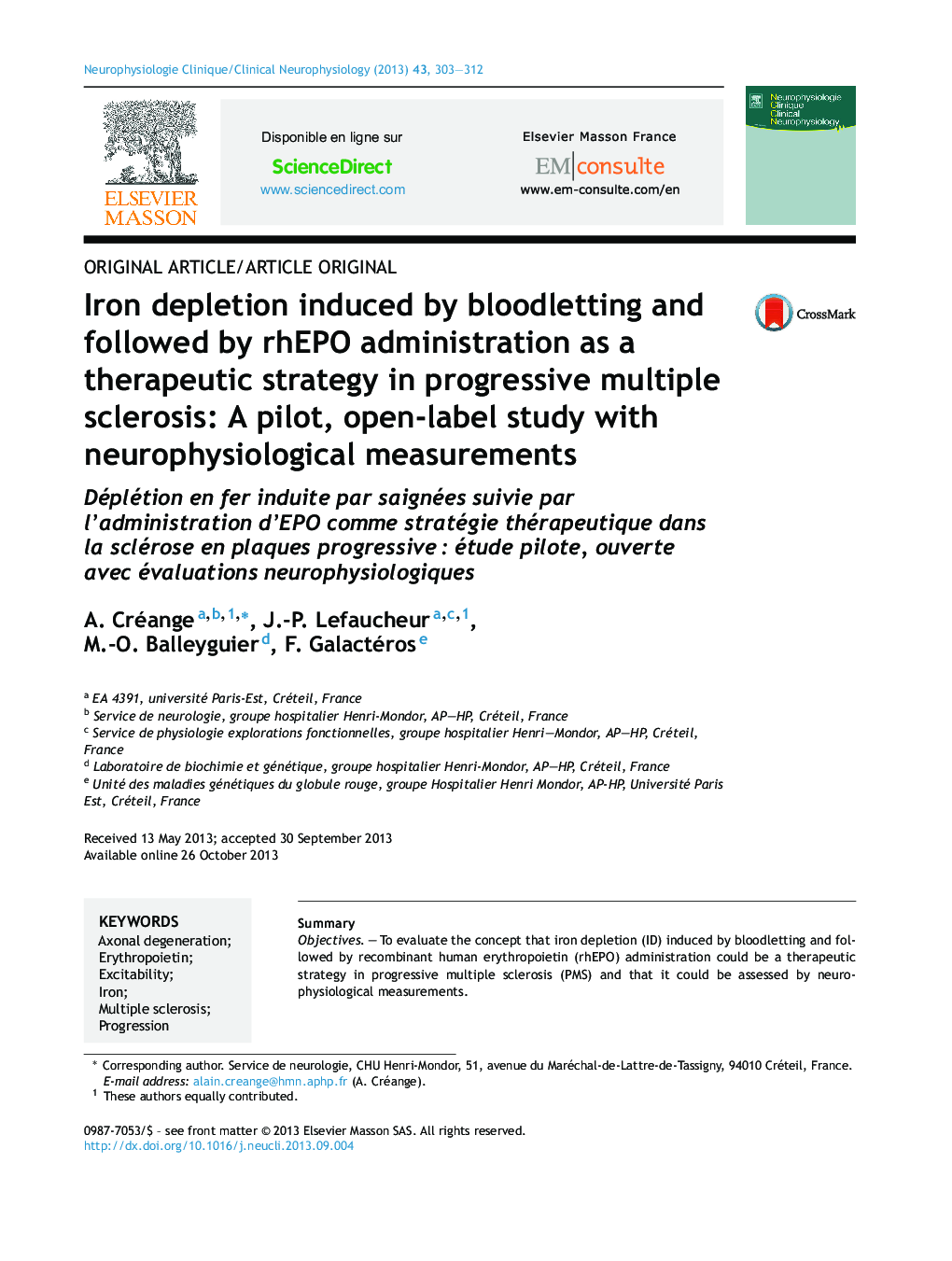| کد مقاله | کد نشریه | سال انتشار | مقاله انگلیسی | نسخه تمام متن |
|---|---|---|---|---|
| 3082286 | 1581107 | 2013 | 10 صفحه PDF | دانلود رایگان |

SummaryObjectivesTo evaluate the concept that iron depletion (ID) induced by bloodletting and followed by recombinant human erythropoietin (rhEPO) administration could be a therapeutic strategy in progressive multiple sclerosis (PMS) and that it could be assessed by neurophysiological measurements.Patients and methodsIn four patients with PMS, bloodletting was performed until ID was induced, and then rhEPO was administered (300 UI/kg/week). The changes induced by the treatment were assessed by clinical scores, biological tests, and neurophysiological study of cortical excitability using transcranial magnetic stimulation techniques.ResultsThe treatment was well tolerated except for muscle cramps and one popliteal vein thrombosis in a patient confined to chair. ID was obtained within 28 weeks and was associated with endogenous production of EPO. No bloodletting was further required during a six-month period after introduction of rhEPO. At the end of the follow-up (up to one year), fatigue and walking capacities tended to improve in two patients. Neurophysiological changes were characterized by an increased cortical excitability, including a decrease of motor thresholds and an enhancement of intracortical facilitation and cerebellothalamocortical inhibition.ConclusionsThe combined ID-rhEPO therapy could authorize a prolonged administration of rhEPO in PMS patients, able to modify cortical excitability of the glutamatergic and gabaergic circuits. These preliminary data are encouraging to design a larger, controlled therapeutical trial to assess the value of such a strategy to improve functional symptoms in PMS patients, and maybe to prevent axonal degeneration. Neurophysiological measurements based on cortical excitability studies could provide sensitive parameters to evaluate treatment-induced changes in this context.
RésuméObjectifsÉvaluer le concept que la déplétion en fer (DF) induite par des saignées répétées et suivie par l’administration d’érythropoïétine recombinante humaine (EPO-rh) pourrait être une stratégie thérapeutique dans la sclérose en plaques progressive (SEP-P) et que ceci peut être évalué par des mesures neurophysiologiques.Patients et méthodesChez quatre patients atteints de SEP-P, des saignées ont été effectuées jusqu’à ce qu’une DF soit induite, puis l’EPO-rh a été administrée (300 UI/kg par semaine). Les changements induits par le traitement ont été évalués par des scores cliniques, des tests biologiques et l’étude neurophysiologique de l’excitabilité corticale à l’aide des techniques de stimulation magnétique transcrânienne.RésultatsLe traitement fut bien toléré en dehors de crampes et de la thrombose d’une veine poplitée chez un patient confiné au fauteuil. La DF a été obtenue dans un délai de 28 semaines maximum et fut associée à la production endogène d’EPO. Aucune saignée ne fut nécessaire dans les six mois suivant l’introduction de l’EPO-rh. A la fin du suivi (jusqu’à un an), la fatigue et les capacités de marche tendaient à être améliorées chez deux patients. Les changements neurophysiologiques étaient caractérisés par une augmentation de l’excitabilité corticale, incluant une diminution des seuils moteurs et une amélioration de la facilitation intracorticale et de l’inhibition cérebello-thalamocorticale.ConclusionsL’association thérapeutique DF-EPO-rh pourrait permettre une administration prolongée d’EPO-rh chez les patients SEP-P, capables de modifier l’excitabilité corticale des circuits glutamatergiques et gabaergiques. Ces données préliminaires sont encourageantes pour concevoir un essai thérapeutique contrôlé de plus grande ampleur, afin d’évaluer la valeur d’une telle stratégie pour améliorer les symptômes fonctionnels de patients atteints de SEP-P et peut-être de prévenir la dégénérescence axonale. Les mesures neurophysiologiques basées sur l’étude de l’excitabilité corticale pourraient fournir des paramètres sensibles pour évaluer les changements induits par le traitement dans ce contexte.
Journal: Neurophysiologie Clinique/Clinical Neurophysiology - Volume 43, Issues 5–6, December 2013, Pages 303–312